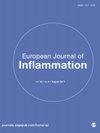ApoE基因多态性在青海藏族人群中的分布特征
IF 0.8
4区 医学
Q4 IMMUNOLOGY
引用次数: 0
摘要
目的:了解青海藏族载脂蛋白E(APOE)等位基因相对频率的分布特点,为后续研究提供依据。方法:采用聚合酶链式反应-限制性片段长度多态性(PCR-RFLP)方法,对青海省人民医院体检中心随机抽取的96名藏族土著人群进行APOE基因型测定和分布特征分析,并与国内其他民族进行比较。结果:96例受试者中E2、E3和E4等位基因的频率分别为1.563%、89.062%和9.375%,基因型频率分别为E2/E2(0%)、E2/E3(3.125%)、E2-E4(0%),E3/E3(78.125%)、E3/E4(18.750%)和E4/E4(0%)。ε2等位基因在藏族人群中的频率分布低于中国北方汉族、南方客家人、回族、蒙古族和傣族人群。ε4等位基因在藏族人群中的频率分布与北方汉族、南方客家人、回族和蒙古族人群相比没有显著差异,但高于傣族人群。ε3等位基因在藏族人群中的频率分布与北方汉族、蒙古族和傣族人群相比没有显著差异,但高于南方客家人和蒙古族人群。结论:APOE三种常见等位基因的频率分布存在民族差异。本文章由计算机程序翻译,如有差异,请以英文原文为准。
Distribution characteristics of ApoE gene polymorphism in the Tibetan population of Qinghai
Objective: To understand the distribution characteristics of the relative frequencies of apolipoprotein E (APOE) alleles in Tibetans of Qinghai province, to provide a basis for subsequent research. Method: Polymerase chain reaction-restriction fragment length polymorphism (PCR-RFLP) was used to determine the APOE genotypes and analyze the distribution characteristics in 96 indigenous Tibetans randomly selected from the Medical Examination Center of Qinghai Provincial People’s Hospital, and the results of this study were compared with those of other ethnic groups in China. Results: The frequencies of E2, E3, and E4 alleles in the 96 subjects were 1.563%, 89.062%, and 9.375%, respectively, and the genotype frequencies were E2/E2 (0%), E2/E3 (3.125%), E2/E4 (0%), E3/E3 (78.125%), E3/E4 (18.750%), and E4/E4 (0%), respectively. The frequency distribution of the ε2 allele in the Tibetan population was lower than that of the Northern Han, Southern Hakka, Hui, Mongolian, and Dai populations of China. The frequency distribution of the ε4 allele in the Tibetan population was of no significant difference compared with that of the Northern Han, Southern Hakka, Hui, and Mongolian populations, but was higher than that of the Dai population. The frequency distribution of the ε3 allele in the Tibetan population was of no significant difference compared with that of the Northern Han, Mongolian, and Dai populations, but higher than that of the Southern Hakka and Mongolian populations. Conclusion: There are ethnic differences in the frequency distribution of the three common alleles of APOE.
求助全文
通过发布文献求助,成功后即可免费获取论文全文。
去求助
来源期刊
CiteScore
0.90
自引率
0.00%
发文量
54
审稿时长
15 weeks
期刊介绍:
European Journal of Inflammation is a multidisciplinary, peer-reviewed, open access journal covering a wide range of topics in inflammation, including immunology, pathology, pharmacology and related general experimental and clinical research.

 求助内容:
求助内容: 应助结果提醒方式:
应助结果提醒方式:


